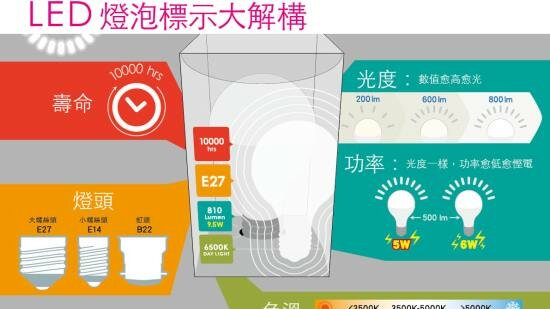The Consumer Council collaborated with the Electrical and Mechanical Services Department (EMSD) to test 10 models of LED home-use light bulbs and found out the efficacy can vary as much as 100%. After being operated for about one-tenth of the claimed lifespan, 1 model had samples with lumen output significantly dropped or burnt out, while a few models failed to pass all safety test items. Consumers have to be extra cautious in selecting the products.
The Council commissioned an independent local laboratory to conduct tests on the performance and photobiological safety of LED light bulbs. Performance standard of LED light bulb commonly requires a 6,000 hours (about 8 months) test. However, as new models launch frequently in the market, in order to avoid most models becoming obsolete by the time that the report is published, the Council has shortened the testing period to 3,000 hours (about 4 months) and released the report timely for consumers' reference.
The 10 tested light bulb models included 2 warmwhite candle light bulbs and 8 daylight globe light bulbs, with price ranging from HK$47 to HK$178 and claimed lifespan between 15,000 and 50,000 hours. 3 models scored the maximum 5 marks in the test, while the worst-performing model scored 2 marks only.
Consumers usually choose their light bulbs based on their luminous flux, luminous efficacy and lifespan. The unit of luminous flux is lumen, the larger the value of lumens, the brighter the light. Luminous efficacy is calculated based on the lumen output per watt of power (lumen/watt, lm/W). The higher the luminous efficacy, the better the energy efficiency for the same amount of lumen output. It was found that the luminous efficacy of the models was found to vary from the lowest 53.8lm/W to nearly double at 107lm/W.
The lumen output of light bulb will reduce after usage for a period of time. After igniting for 3,000 hours, only 1 model maintained its initial lumen output, while the others dropped by 1.3% to 28.2%. The lumen output of 5 models has dropped more than 5%, failing to meet the requirement of the EMSD Voluntary Energy Efficiency Labelling Scheme for LED light bulbs. According to the Scheme requirements, the lifespan is defined as the point at which the lumen output of an LED light bulb has declined to 70% of its initial lumen when it is considered that the light bulb should be replaced. Besides, among the 10 tested samples of one individual model, 7 samples were found to have significantly dropped in the lumen output or burnt out after usage for 3,000 hours, 90% short of its claimed lifespan.
Manufacturers claim that the lifespan of LED light bulbs can be over 10,000 hours, ranging from 15,000 hours to 50,000 hours. As there is still no commonly used international testing method to accelerate the life test of LED light bulbs, the manufacturers would have adopted different methods to estimate the claimed life expectancy of their own products, and therefore, consumers by no means could compare the products under the same standard. Consumers have to pay extra caution when making a choice.
Furthermore, the EMSD commissioned a local independent laboratory to conduct safety test according to the international safety standard IEC 62560. Results showed that 3 models failed to pass all the test items, with one model did not meet the requirement for protection against electric shock and insulation. Its diffuser also failed in the torque test and the dimension of lamp cap is slightly different from the standard lamp base. The supplier pledged to the EMSD for a prompt follow up and indicated that the tested model has already stopped manufacturing and supplying.
Furthermore, the marking of 4 models were found to be inadequate, for instance, missing the input current and frequency. The marking of another model was not legible after the rubbing test.
The rated voltage of most of the tested models are marked in range, such as 220V to 240V, therefore the wattage and lumen output measured by the Council under Hong Kong's mains voltage (220V) may not be suitable for direct comparison with the manufacturer's rated value. The Council urged the agents to indicate the value measured under 220V as a standard to make it easier for consumers to compare different products or shall state it very clearly.
Consumers are advised to take heed of the following when purchasing and using LED light bulbs.
- Compare the lumen output when selecting different brands of light bulbs. If the lumen output is the same, the one with lower wattage is more energy saving;
- The lifespan of LED light bulb will be shortened if it operates at an environment with high temperature;
- Some LED light bulbs are not dimmable, please take note of the warnings on the light bulb or packing;
- As some LED light bulbs are heavy, beware of the load-bearing capability of the lamp holder during installation;
- Do not touch an operating light bulb and remember to switch off the power before replacing one. If any abnormality is found such as overheating and flickering, stop using it immediately.
The Consumer Council reserves all its right (including copyright) in respect of CHOICE magazine and Online CHOICE ( https://echoice.consumer.org.hk/ ).



